“How are you?” asked a sign in the foyer of Clifford Gallery. Below, a QR code enabled visitors to enter quotes and images as part of a digital project titled be by Anna Rapson ’21. In the main gallery, large-scale paintings; colorful, abstract sculptures; and a chair made of vibrant Easter eggs were among the final projects on display in early May.
During the spring semester, 15 senior art majors created their final student works that offered commentary on society, examined the self, and explored personal themes. They were guided by Professor Lynette Stephenson and their classmates in Arts 406 as well as their individual advisers.
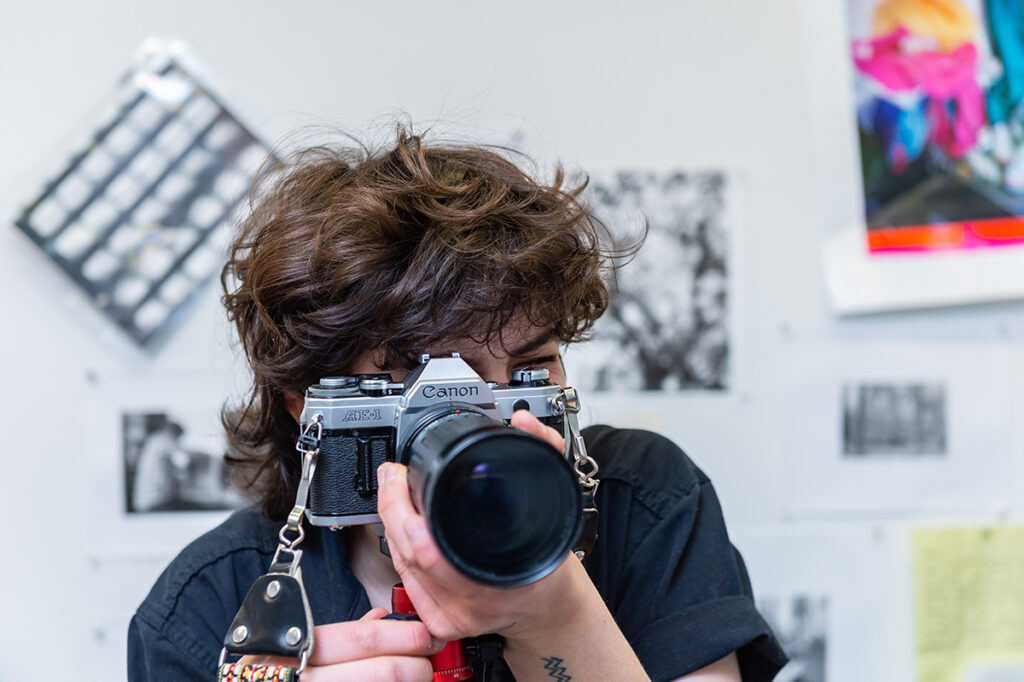
The students spent the semester pondering how their work fits into art theory and how it contributes dialogue in the world. Also important: that they “feel ownership or connection to their project; it’s a concept that they developed themselves and can see it through,” says Stephenson, who taught the class for the fifth time. “There should be a clear indication of beginning through the end — some growth, where the choices they thought about at the beginning might completely change as they work with whatever medium they’re using.”
Meet four of the artists.
Still Lives Through a Modern Lens
Juul pods, French fries, cigarettes, Dunkin’ takeout. Alone, these items people consume are, eventually, trash. But arranged in an ornate setting by Sofia Perez-Dietz ’21 (pictured left), they become art — and maybe even beautiful.
“I am interested in what is and is not considered valuable, but more curious about how significance is constructed and understood,” Perez-Dietz says in their artist’s statement.
Photographing with 35-millimeter, black and white film, Perez-Dietz uses red, blue, and green filters. Perez-Dietz then layers the negatives to achieve the colors they want; final pictures may be composed of as many as 11 photographs.
“The arduous process of constructing color from B&W film allows the photographs to feign themselves as painting, which exploits viewers’ expectation that still lives depict hyper-precious items,” they write in their statement.
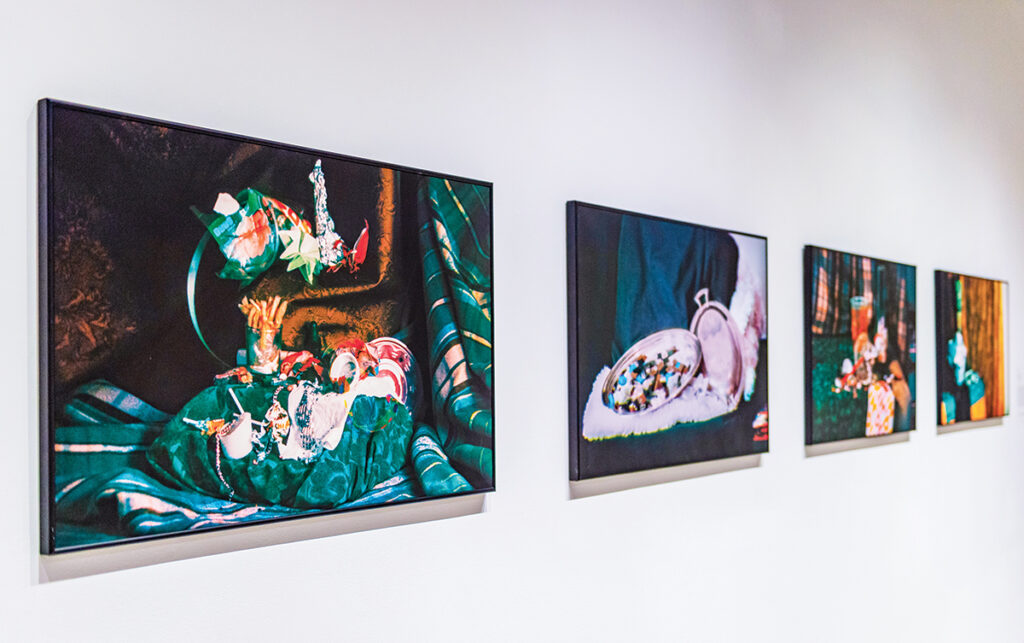
Taking art theory and painting classes, Perez-Dietz developed this concept when thinking about how, in the Dutch Golden Age, art was intended to replicate reality. Transferring that idea from the canvas to the camera, Perez-Dietz pondered the notion that today, photographs are thought to be depictive of real life. But, in both instances, that’s not entirely accurate.
In the 17th century, still life paintings included items like lobsters and lemons, but “we don’t see it as exotic or strange; it naturalizes it,” Perez-Dietz comments. Similarly, today, items like fast food and drugs are normalized. “The objects … aren’t seen as trash from the get-go, rather they have roles in users’ lives as both precious and necessary until they become disposable,” Perez-Dietz explains in their artist’s statement.
Examining the medium itself, Perez-Dietz says, “Everyone has a little camera in their pockets… When you think about iPhone pictures or journalism photography, it’s important to think about how cameras can make things really naturalized.”
Perez-Dietz, in selecting the objects pictured, hopes viewers examine: What are we eating? What are we consuming? What do we show off? What do we not show off?
“I’ve been led here subconsciously, with both this art history and art theory education,” Perez-Dietz says. “Being an art major at a liberal arts school is a really interesting phenomenon… We’re not just learning skills, we’re learning how to think, and that makes projects like this really rich and exciting.”
Love and Loss
After her dad passed away in the summer of her sophomore year, Allegra Knox ’21 found solace at the easel, a place they had in common. Like her dad and paternal grandmother, Knox has become a painter. “It must run in the family,” she says.
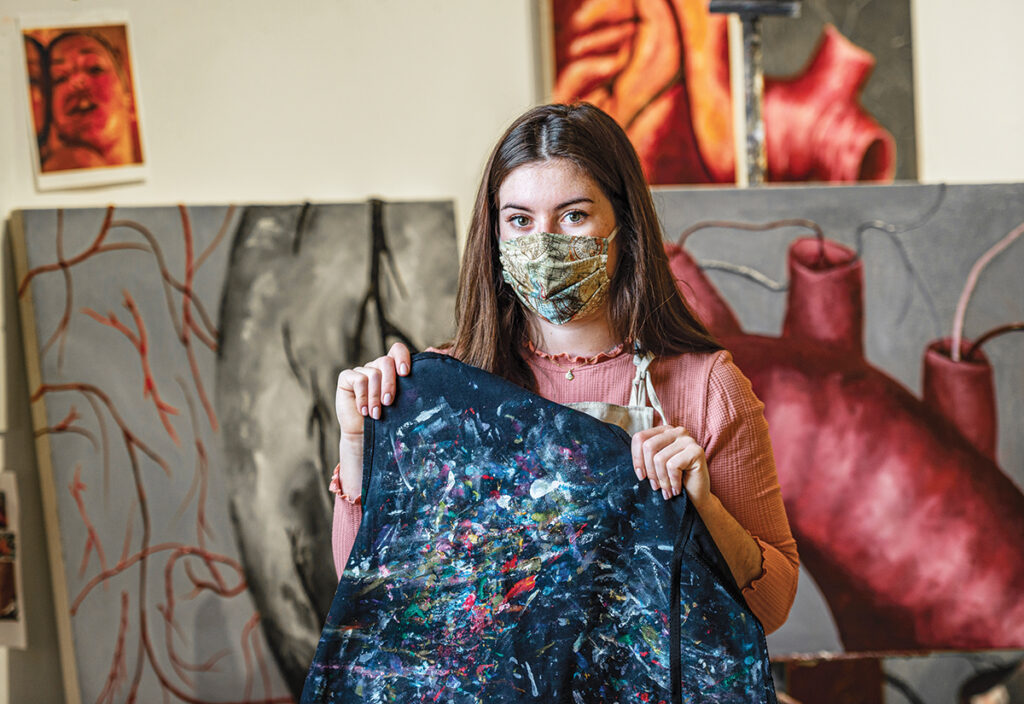
In this time, she painted memories that bubbled to the surface. There was the funeral home, where she remembers that, while her mom was having a conversation, Knox was distracted by an oddly oversized bowl of Mentos on the table. “I just thought it was so bizarre,” she recalls, “…it was enormous.”
Another moment: She’d spotted a blue jay, and “I felt like that bird was my dad coming to say ‘hi’.” These flashbacks became permanent on her canvas.
A third painting symbolized her dad’s cooking, “one of his love languages”: an open kitchen drawer holding chef’s knives, with his initials engraved on the blades.
Approaching her senior year project, Knox initially considered something related to the artwork of her grandmother, who created charcoal drawings and oil paintings. But when Professor Lynette Stephenson prompted students to creatively meditate on time or place, Knox thought of her dad and his unexpected death due to cardiomyopathy (an enlarged heart). “I chose to draw a big heart to represent time … your heart is a clock of sorts,” she says. Thinking of the common expression “ticker,” she adds, “it’s like a timer for your life.”
As she continued, Knox “grew to like the shape more and more.” And, knowing she wanted to create a large-scale painting (like her dad’s art), the concept of an enlarged heart on canvas clicked.
Working through her bereavement, Knox threw herself into her project, spending hours a day in the studio. One piece turned into six — now titled Fragment. “Each canvas is a small glimpse of the sorrow, isolation, and numbness that comes with such a deep loss, though there are pieces of life, celebration, and beauty within as well,” she explains in her artist’s statement. “The bloody, fleshy tones in some of the canvases represent the rawness of the trauma, while simultaneously there are beautiful aspects in the light pinks and soft curves on some of the paintings.”
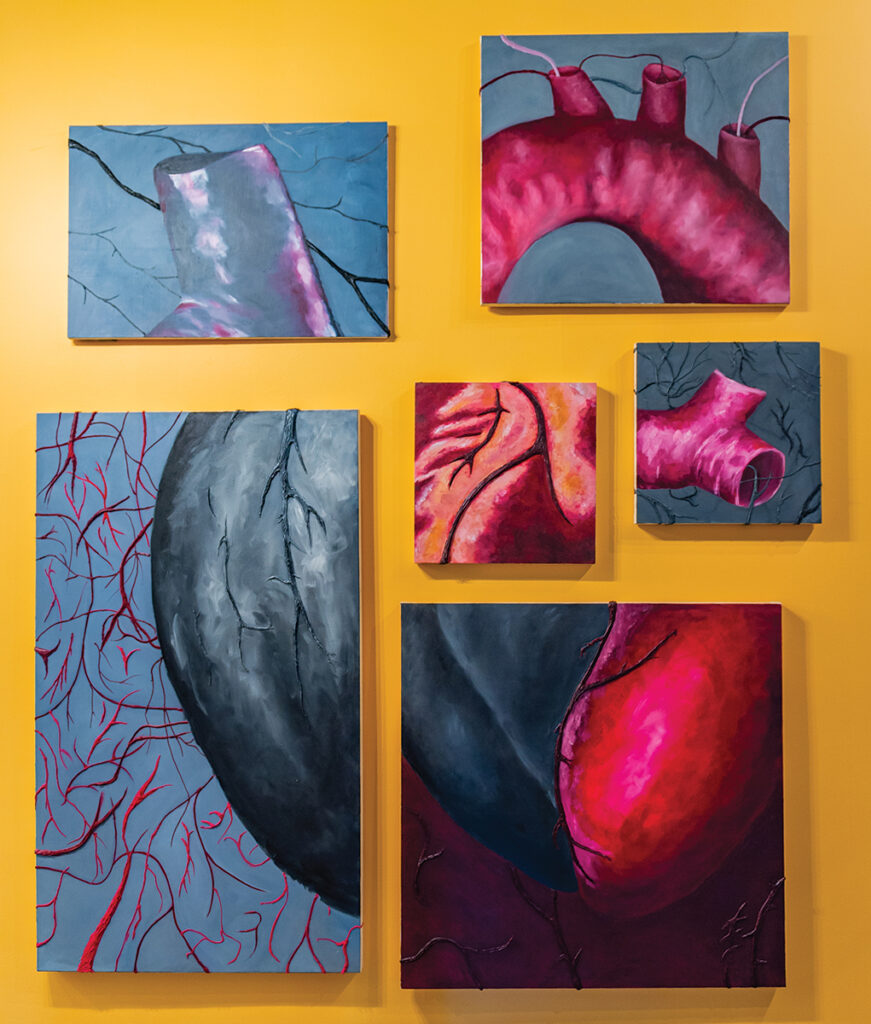
With the technique of piping, she created 3D veins: “… sometimes they manifest in infectious, unwelcome, tangled-up ways, much like unexpected sadness or triggers,” she wrote in her artist’s statement, “while other times they seem delicate and beautiful, reminding me that the loss only hurts this much because of how strongly I loved and was loved by
my dad.”
The project has helped Knox express her jumble of emotions and feel closer to her dad. “I understand him more now because I’m working on something he felt passionate about, and now I’m passionate about it,” she says. “Sometimes it makes me happy, and sometimes it makes me sad… I just wish I could call him, because in prior years, I would always tell him what I was learning in my art classes and we’d have really good conversations.” She adds: “But then, it’s so cool that I’m doing this because I know my dad would be really excited for me.”
One silver lining, Knox notes, is that she’s developed new relationships with her extended family. “I don’t think that would’ve happened had my dad not passed away. There is a lot of badness and sadness and negative emotion, but there are also some positive emotions that have come out of it too.”
Constructed Cartography
This summer, Jared Lampal ’21 is hiking the Appalachian Trail, marking more points on his life’s map. Before embarking on this months-long adventure, Lampal spent his last semester at Colgate traveling a much shorter route: “There are about three places I go every week,” he says, “downtown, to my house, and to Little Hall [where his one in-person class was held].”
This cycle got him thinking about place and time, which took him to his sketch pad. The final product, Mapping the Passage of Time, comprises four large panels representing different periods (counterclockwise from top right): a week, his lifetime, a year, and the future. “[It] is concerned with the ways we visualize life events, important locations, and worldly interactions,” he wrote in his artist’s statement.
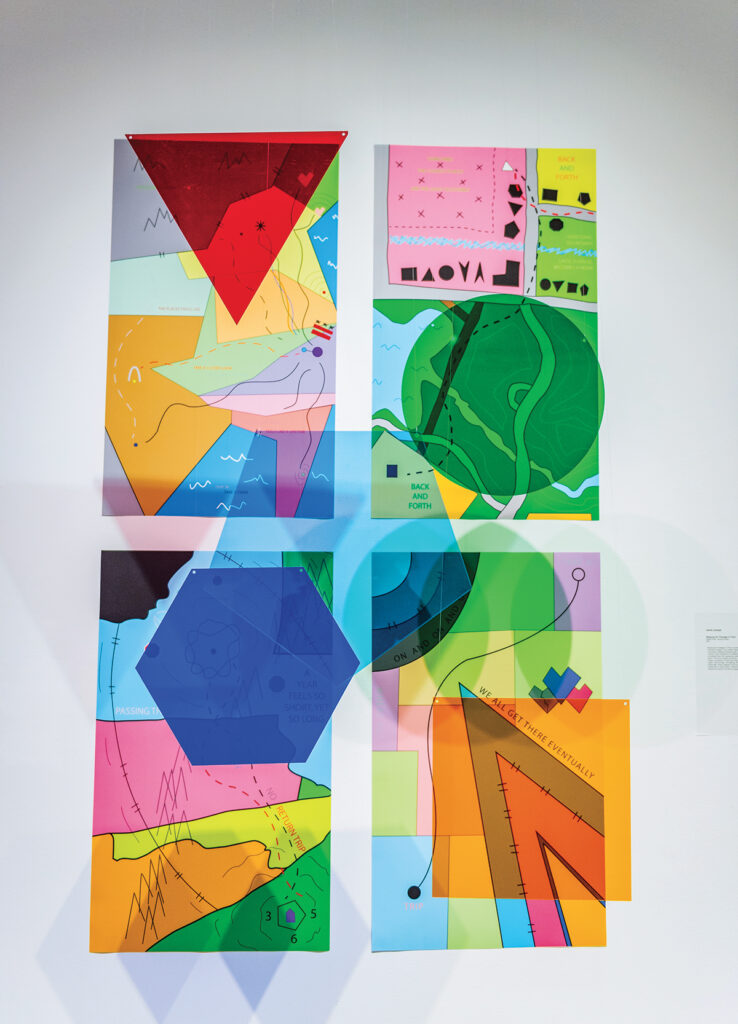
“This is a very personal piece, but it’s not obviously personal,” Lampal explains. “It’s my interpretation of those timeframes, their impacts on my life, and where I go and what I do.”
However, Lampal wants the audience to engage with the pieces from their own perspectives, which he facilitates through certain artistic choices.
“It’s my way of sharing my personal, internal ideas, but also allowing people to think of a way they feel about it themselves that’s unique to just them,” he says.
Lines of text on the maps, such as “Stop and consider” or “Sometimes the closest places are the least accessible,” are intended to inspire contemplation. In front of the panels hang boldly colored geometric shapes, and depending on a person’s height as well as their angle and distance from the art, viewers will see Mapping the Passage of Time differently. The lenses not only change the work from a purely aesthetic standpoint, but also, their color-filtering properties either reveal or hide some of the text, depending on the viewing angle.
A studio art and psychology double major, Lampal is intrigued by how the audience interacts with and is affected by art. “I’ve always thought it was interesting to see what influences the art people like, the art people make, and how art impacts people’s emotions.”
There is no Right Answer
McCloy Leonard ’21 likes to ask questions. Contemplating his senior art project, he deliberated: How do I ground this in contemporary practice? What’s the right answer to this problem I’m facing? Can art be just pretty, or does it have to have a deeper meaning?
These quandaries were at first creating a barrier, but ultimately, a question gave him his answer: Why can’t this be fun?
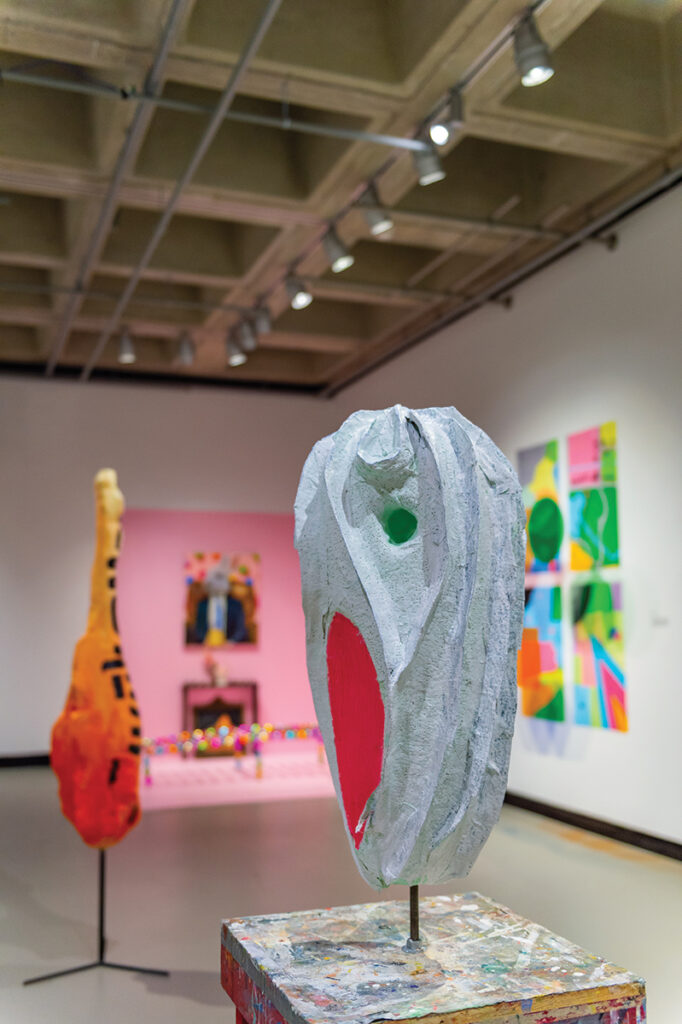
“Once I started playing with the works, things started flowing for me,” he says.
The result is six sculptures that Leonard considers to be “temporal and behavioral aspects of the self,” he explains in his artist’s statement. These metaphorical self-portraits have titles including The Fool and The Fortune Teller.
Each of the sculptures represents a phase, Leonard says. “Existing in different states, with me working on all of them at the same time — that’s the temporal aspect of it … and it’s me wanting to exist in all these different moments.”
Hoping the viewers themselves ask questions, he adds, “I don’t want it to be clear which one came first.”
Leonard, who is inspired by Leonardo da Vinci and French philosopher Roland Barthes, says: “My work is the question without the answer.”
As he concluded this semester-long exploration and prepared his work for exhibition, Leonard posed one last query: “Why do we assume that a sculpture goes on a white box?” So he selected a few bases that, like the pieces, represent process and time: an old painting stool and a used paint can from the studio. “The act of layering paint each semester in a subconscious way [onto the stool and the can], by painting students, is what I want my pieces to highlight: process as art,” he says.
